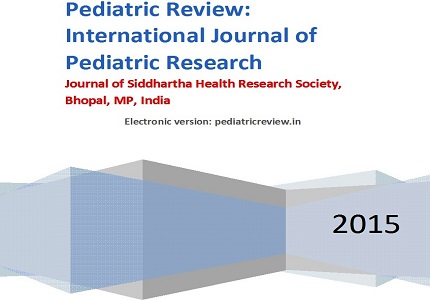Portal vein thrombosis following umbilical vein catheterization in neonates
Abstract
Objective: To study the association of portal vein thrombosis in umbilical vein catheterized neonates.
Study design: Prospective study.
Subjects: Neonates in NICU with umbilical vein catheterization.
Methods: Doppler ultrasound was performed for all neonates within 24-48 hours of catheter insertion, followed by 48-72 hours after its removal and weekly until hospital discharge or clot resolution. Diagnosis of Portal vein thrombosis was made, its extent, location and size was noted.
Result: 30 newborns were screened for portal vein thrombosis. Among them, 17 (57.2%) babies had clinical sepsis, 14(46.7%) had blood transfusion and 7 (23.3%) had calcium infusion through the umbilical vein. Portal vein thrombosis was observed in 3 out of 30 babies (10%). 2 babies had the umbilical tip in inferior vena cava and one baby had in main portal vein. Color Doppler revealed, two babies had partial non-occlusive thrombus in the left portal vein and one baby had in the main portal vein. On follow up, the thrombus of all the babies had resolved by 1-2 weeks. All the 3(100%) neonates with thrombosis received calcium infusion through the umbilical vein and its association was found to be statistically significant with a P Value of 0.086.
Conclusions: Calcium transfusion through umbilical vein catheterization is associated with term portal vein thrombosis, though most of them are clinically silent and resolve spontaneously. Ultrasound can be used as effective tool in early detection of the thrombus and hence as a guide for catheter removal.
Downloads
References
2. Schwartz,DanaS.MD;Gettner,PatriciaA;Konstantino,Monica M; Bartley et al Umbilical venous catheterization and the risk of portal vein thrombosis[Clinical and Laboratory Observation]. The journal of pediatrics.1997: 131(5):760-762.
3. Alvarez F, Bernard O, BrunelleF,HadchouelP,OdievereM,AlagilleD. Portal obstruction in children.Clinical investigation and haemorrhagerisk.J Pediatrics 1983:103(5):696-702.
4. Morag I;EpelmanM;DanemanM,MoineddinR,ParvezB,Schecter T, et al.Portal vein thrombosis in neonates:riskfactors,course and outcome. J pediatrics.2002:148(6):735-9. [PubMed]
5. Stringer DA,KrysylJ,MansonD,BabiakC,DanemanA,Liup.The value of Doppler ultrasonography in detection of major vessel thrombosis in the neonatal abdomen.Pediatric radiology .1990:21:30-3. [PubMed]
6. Kim JH,Lee YS, Kim SH, et al. 2001. Does umbilical vein catheterization lead to portal venous thrombosis? Prospective US evaluation in 100 neonates.Radiology, 219:645–50. [PubMed]
7. Manizhehmostafagharehbaghi, masoodnemati,sakhasedighehhosseinpour,rezataei,robabeghargharechi. Umbilical vascular catheter associated portal vein thrombosis detected by ultrasound. Indian J Pediatr. 2011 Feb;78(2):161-4. doi: 10.1007/s12098-010-0223-x

Copyright (c) 2015 Author (s). Published by Siddharth Health Research and Social Welfare Society

This work is licensed under a Creative Commons Attribution 4.0 International License.


 OAI - Open Archives Initiative
OAI - Open Archives Initiative


